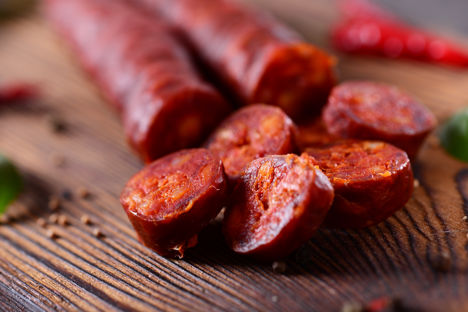
7 of Spain’s most beloved and unusual chorizo sausages
We’re all familiar with the sweet, smoky charms of chorizo, but visit Spain and you’ll find hundreds of regional variations, each with their own subtle differences. Here are a few of Spain’s most popular to look out for.
7 of Spain’s most beloved and unusual chorizo sausages
We’re all familiar with the sweet, smoky charms of chorizo, but visit Spain and you’ll find hundreds of regional variations, each with their own subtle differences. Here are a few of Spain’s most popular to look out for.
There was a time when you’d be lucky to find any sort of chorizo at your local supermarket or butcher, but these days the shelves are overflowing with all sorts of different varieties of the cured Spanish sausage. We often gravitate towards the dry-cured chorizo sarta – sweet, spicy and edible straight out of the packet – but we’re becoming increasingly knowledgeable about how to use this traditional Spanish product. There’s the wafer-thin, salami-style chorizo that sits gracefully in a sandwich; semi-cured, soft chorizo ristra that releases wonderful crimson oils when cooked; smaller chorizo achorizado that’s designed for braising and of course chorizo Iberico, made with meat and fat from acorn-fed Iberico pigs.
Look beyond the most common types, however, and you’ll find hundreds of different regional varieties of chorizo made all over Spain. Wherever you go in the country you’ll find a different style – some regions, such as León, go heavy on the spicy pimentón, whilst others err on the sweet and mild side. Here are a few of the best known and loved regional varieties of chorizo for you to look out for during your next trip to Spain.
The Spanish meat industry as we know it today really started in the Navarre – the Pyrenean-neighbouring plains make fantastic grazing for livestock – and as a result, Chorizo de Pamplona was one of the first chorizos to be made on an industrial scale. It tends to be quite thick – around four centimetres in diameter – and the meat is finely ground, giving it a smooth, spreadable texture. Traditional Chorizo de Pamplona uses equal parts beef and pork, and is packed into sausage casings with smoked paprika and seasoning before being cured and air-dried.
One of Spain’s most famous regional chorizos, Chorizo de León is renowned for its intense spicy flavour. This comes from the heavy use of spicy pimentón, but also from the smoking of the sausage after it has been stuffed and cured. Both ends of the sausage are tied and hung on poles over the smoke, giving Chorizo de León its recognisable horseshoe shape, as well as a deep scarlet hue.
La Rioja has a long tradition of sausage-making and links of Chorizo Riojano (which gained PGI-protected status in 2008) are a common sight all over the region. Because it is a protected product it must be made to specific traditional standards – the meat must be a mixture of lean pork, pork belly and streaky bacon taken from female white pigs, packed into a natural casing of pig’s intestine. After curing and air-drying, the flavour that results is well-balanced – intense, long-lasting smoke from the pimentón, with a hint of garlic.
Another PGI-protected sausage, Chorizo de Cantimpalos is recognised all over Spain as one of the oldest and most versatile chorizos. Its PGI status requires it to be made to rigid specifications – the meat must be taken from castrated pigs that have been fed a diet of cereal crops, and the sausage must be air-dried in the same natural cellars that have been used for hundreds of years. Chorizo de Cantimpalos comes in three types: string is a smaller sausage, aged for at least twenty-one days; achorizado is larger in diameter and aged for twenty-four days and cular is aged for forty days or more, giving it the most intense flavour of the three.
Made using lean pork and cured belly from Galician pigs, as well as sweet pimentón, garlic and other seasonings, Chorizo de Galicia is cured, smoked and air-dried, and usually stored in oil in smaller links. There are a number of other variations too, including ceboleiro – a Galician chorizo made with onion, and Chorizo de Celanova which is made with pumpkin! These chorizos make great all-rounders – because they’re smoked and dried, they can be eaten as they are, or fried, braised and roasted.
Chorizo de Cantabria is one of Spain’s most popular sausages, thanks to its distinct flavour. Like many others it uses a mixture of lean pork, belly and streaky bacon, but mixes things up with lots of herbs – particularly oregano and thyme which grow plentifully in the north of Spain. It is then smoked over oak for twenty-five days, which combines with the herbs to give this chorizo its inimitable taste.
Extremadura is the heart of jamón ibérico country, and the presence of Iberian pigs here also contributes to the quality of Chorizo de Extremadura. You’ll find plenty of typical chorizo sarta here, but keep an eye out for the highly unusual patatera Extremadura – a potato sausage made with a mixture of baked potato, Iberico pork and pimentón. It’s totally unique to this part of northern Spain, and is usually eaten like a sobrasada, spread on fresh bread.


